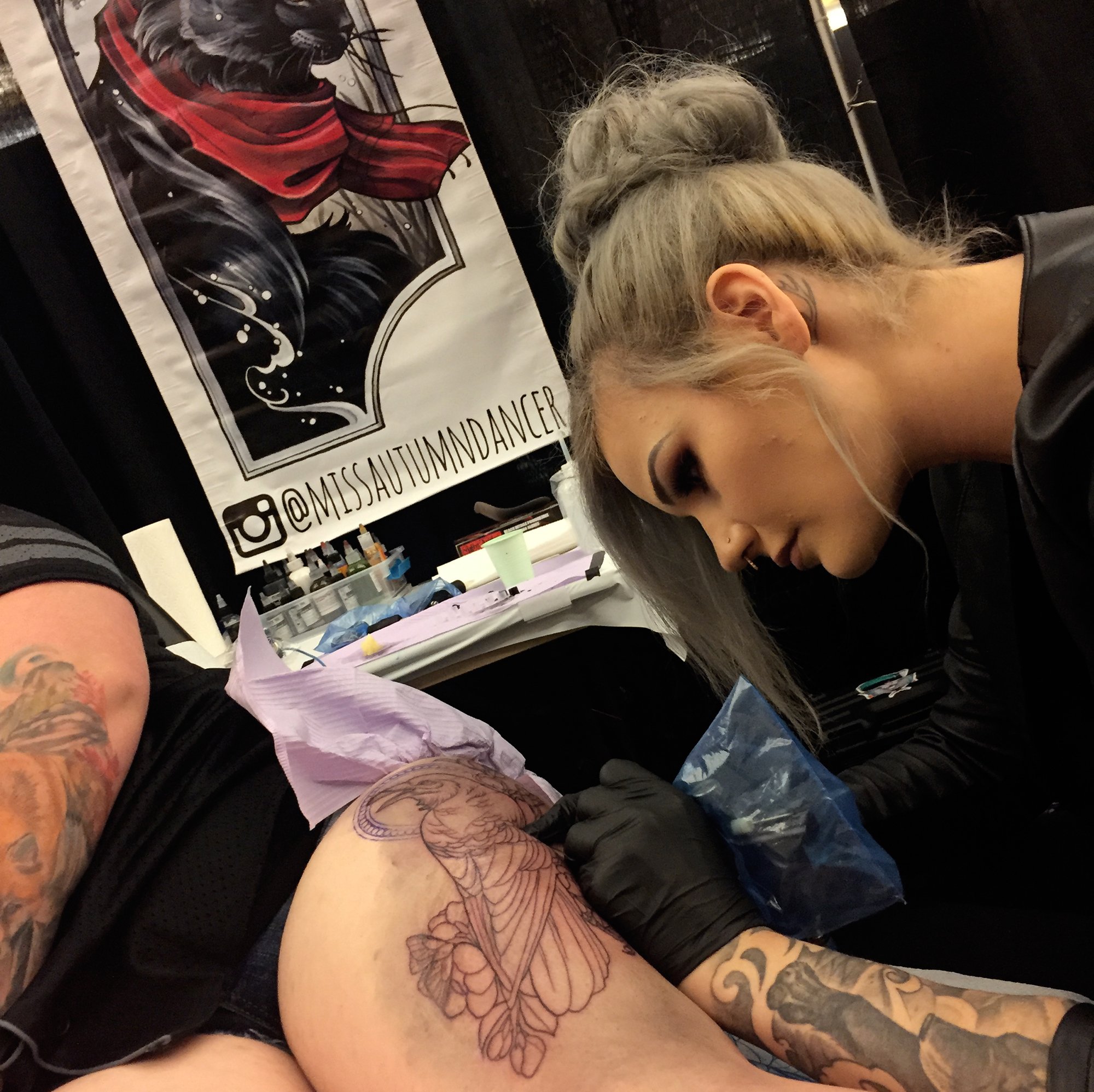
A relative up-and-comer in the tattoo industry, Autumn Dancer has rapidly become an in-demand artist.
Describing her style as a sort of “magical photorealism,” Dancer’s dark fantasy tattoos breath life into creatures that could not possibly exist in reality. While her professional time is dedicated to working on clients and attending conventions like the Van Isle Tattoo Expo, her off time is dedicated to her first love: charity work.
Often traveling with her professional peer and romantic partner James Greenaway, Dancer’s earnest, empathetic energy drives her creative practices, and that it draws from the very root of who she is.
Above: Animal lover Autumn Dancer creates often wildlife and pet tattoos on her clients.
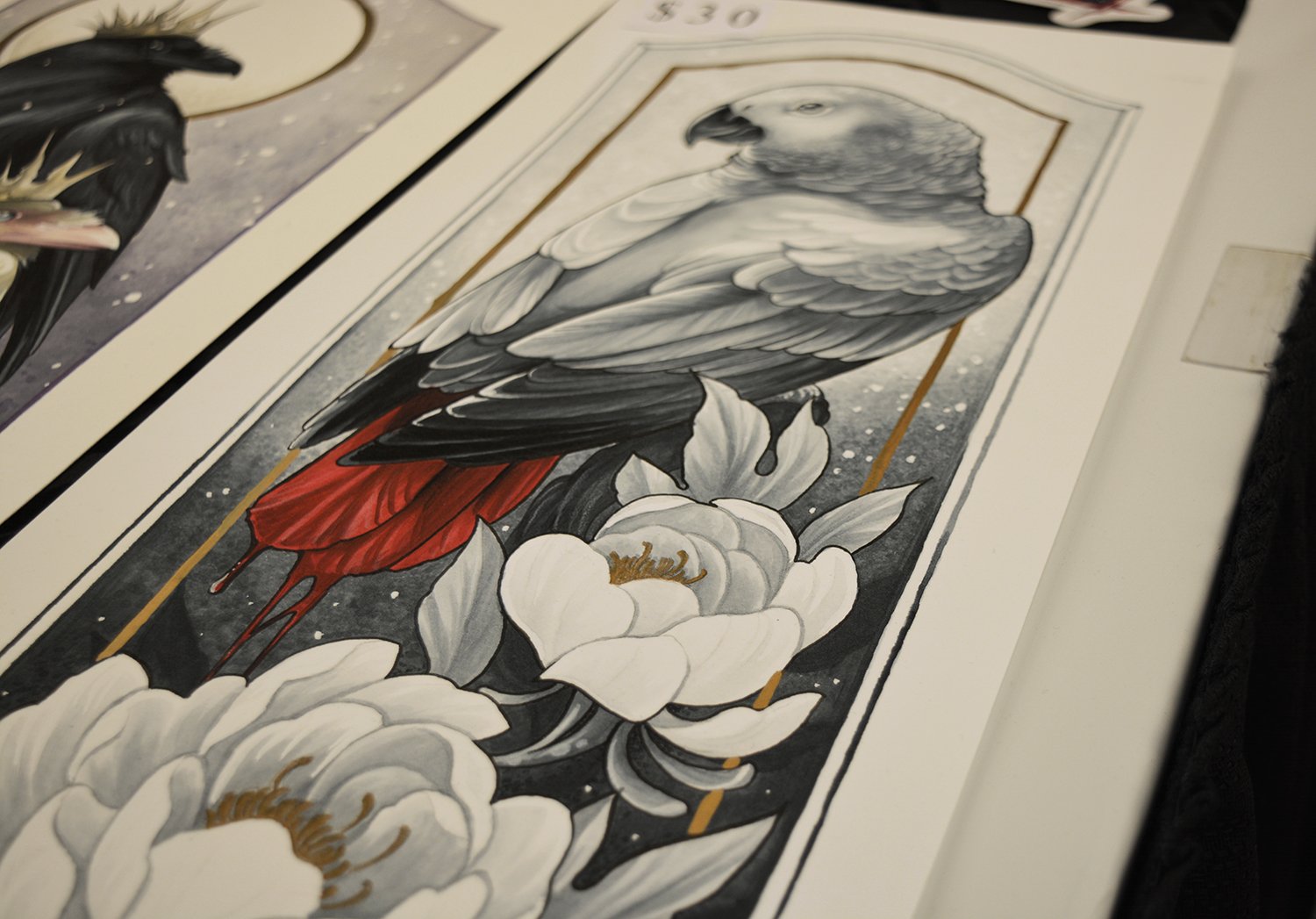
Dancer’s love of birds is clearly seen in her artwork
What was your primary motivation to taking up the practice of tattooing?
I have been drawing ever since I can remember wielding a pencil pretty much. When I got into high school I had a lot of people ask me to draw tattoos for them for ideas for what they want to get tattooed. At the time I never thought it was something I could really get into because not only was it was a boy’s club, but it was something I was intimidated to get into. It was a very knit community. As I got older I was getting tattooed and I wanted to get something I was more interested in because I did draw and I didn’t think with a drawing career that you could get anywhere with it. So it was by chance that I got into tattooing. I was kind of interested in getting into it and someone who knew I could draw really well said “hey, your drawings are amazing, they would do really well as a tattoo, would you like an apprenticeship.” At the time I was looking into getting into EMS and firefighting. My house caught on fire when I was eighteen/nineteen and the firefighters went back in and saved my cat so I was really really pursuing that.
But then I got into tattooing, drawing, and decided “wow this is a lot different than I thought it would be.” It was a lot more enjoyable than I thought. I was terrified of not being able to erase something once it was on skin, but once you get the hang of it, it’s so fluent.
So that’s kind of how I got into tattooing. It’s a long story, but that’s the really compact version of it.
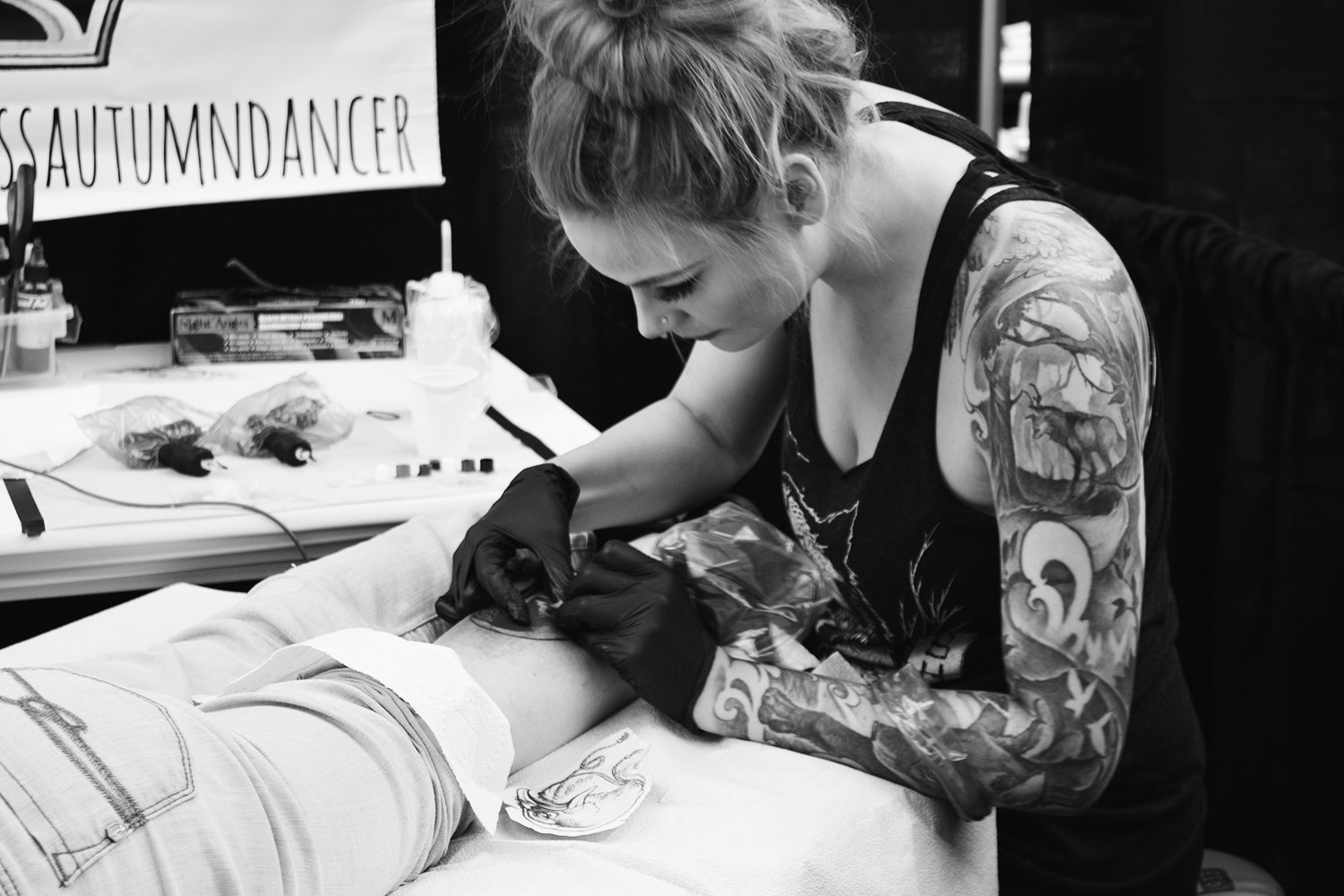
The Canadian artist works on her first tattoo at the Van Isle expo.
You have done some design work for Sane Clothing and have posted pieces done on wood and canvas on your Instagram. Can you tell me more about your background in visual art?
Woo, that one’s tough. I never did art as a profession so I dabbled in everything. I did everything between markers, wood, canvas was the hardest one for me, I struggled with paint and acrylics because of the layering. But I did a lot of pencil crayon and pen when I was a lot younger. I found that tattooing, the closest one for me was pencil crayon because the way you draw things and blend is very very similar. In a sense darks and lights, how much you can layer over top of it, pencil crayon reminds me very much of the contrast between greyscale tattoos, so that I found was the easiest for me to translate it to was working in that medium. But right now I’m in love with Copic pens just because it’s high-saturated colour. I dabbled in everything growing up so I never really specialized in anything.
Sane Clothing, they basically said “hey we like your stuff, could you design whatever you want for us and we’ll do something with it.” That was watercolour images that they took that I painted and they were able to transfer it on t-shirts. So that was a little bit different.
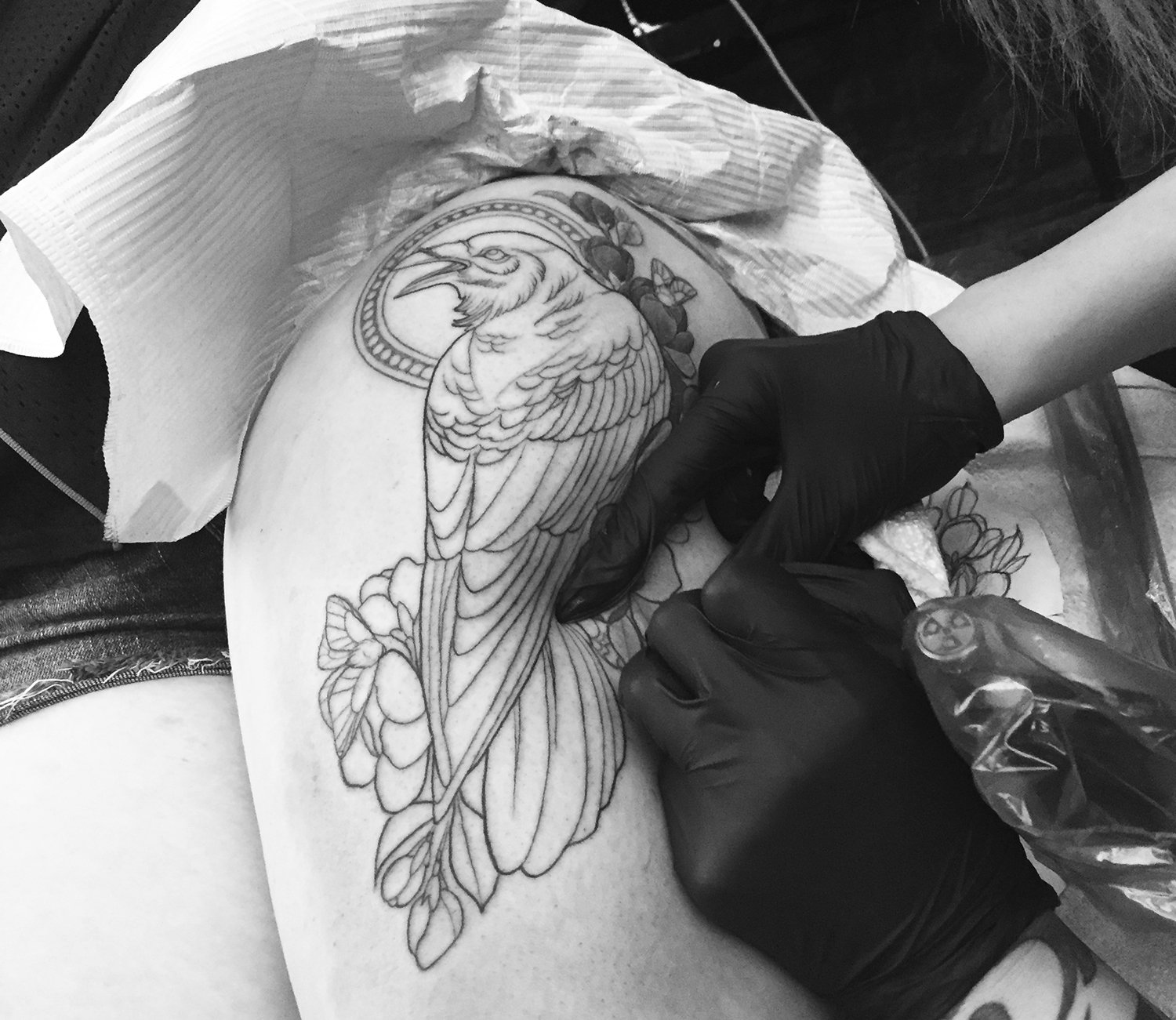
The linework of the white raven tattoo is almost done.
That must have been really cool to have them reach out to you like that.
Yeeeah. It was more surreal seeing somebody walk down the street and be like “that’s my drawing.” And they had no clue it was me because they don’t tell you what artists do them. I was like “hey I drew that” and I took a picture of them and I was super proud. It’s almost like the first time you get to do your own drawings on people.
When I first started tattooing it was a lot of script or tribal or little butterflies or just stuff that you don’t take pride in. But the first time someone is like “I like your stuff, draw me a bird the way you would,” and you have to put your own drawing on somebody, that was a super surreal proud moment. Yeah.
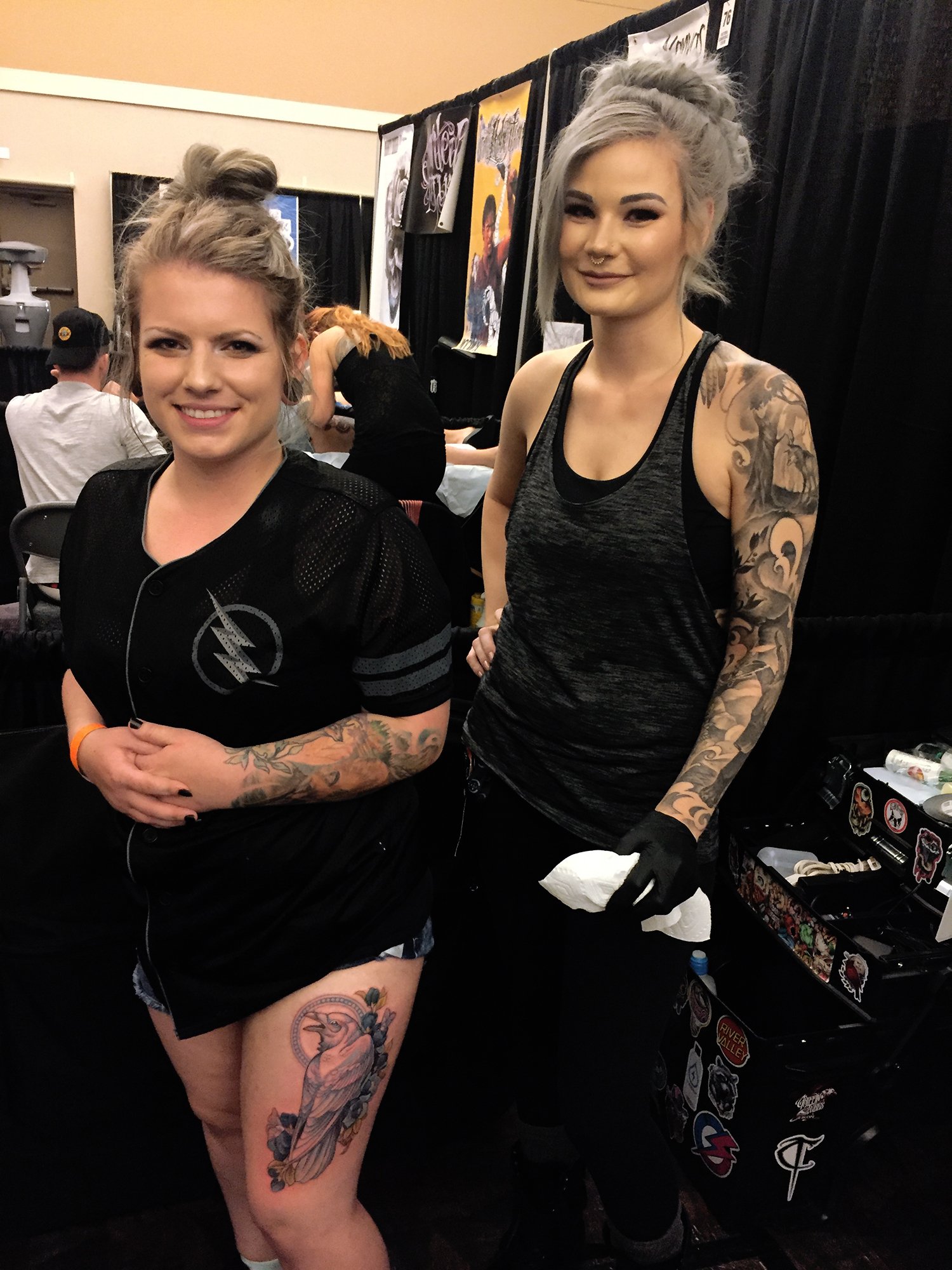
Artist and model standing proudly with the work in progress.
You have worked at two other studios over the course of you career, Bombshell Tattoo and Kamikaze Tattoo. Based on photographs of your work from those times, your style has really matured. Can you explain how your experiences there changed you as an artist?
Not necessarily the style, but working with other artists—uh, you learn and you pick up things the more artists you work with because you get influenced by the people you are around. So I found that when I apprenticed somewhere I didn’t quite like the atmosphere there, I ended up moving to a different shop. From there I picked up things that artists from my first shop didn’t know. I was more into watercolor tattoos when I was at Bombshell and then I started going to Neo-Traditional Tattoos at Kamikaze, and now I find myself doing more Illustrative or Magical Realism or Illustrated Realism. It’s still lined like a tattoo but it has the textures of a realistic animal.
And then coming to Capital—I have been there for three and a half years—and the caliber of artists that work up there was higher so I felt like it pushed me to be on the same level as them. So I did find that every artist I ever worked with and every shop gave me—[i.e.] I took a piece of the thing I learned from them and slowly put that towards my tattooing. So yeah even over the last couple years, I go over my old stuff and wow like, I used to love watercolor tattoos and now I absolutely hate them.
I think an artist should always grow no matter what. If they’re not accelerating or getting better I feel like they’re—I don’t know what the word is for it, but you should constantly be learning. If you stop learning there is no point in continuing that art because if you’re at the top of where you can be there’s nowhere to go, no one to learn from, there’s nothing to work towards. It’s almost like you hit a plateau and you just don’t feel fulfilled. But growing as an artist—I get better with every tattoo I do. I look back at my last one and I learn from what I did last time, and I look at other artists on the internet and I grab a little piece of what they did and add it to my tattoos. Yeah, it’s an awesome feeling.
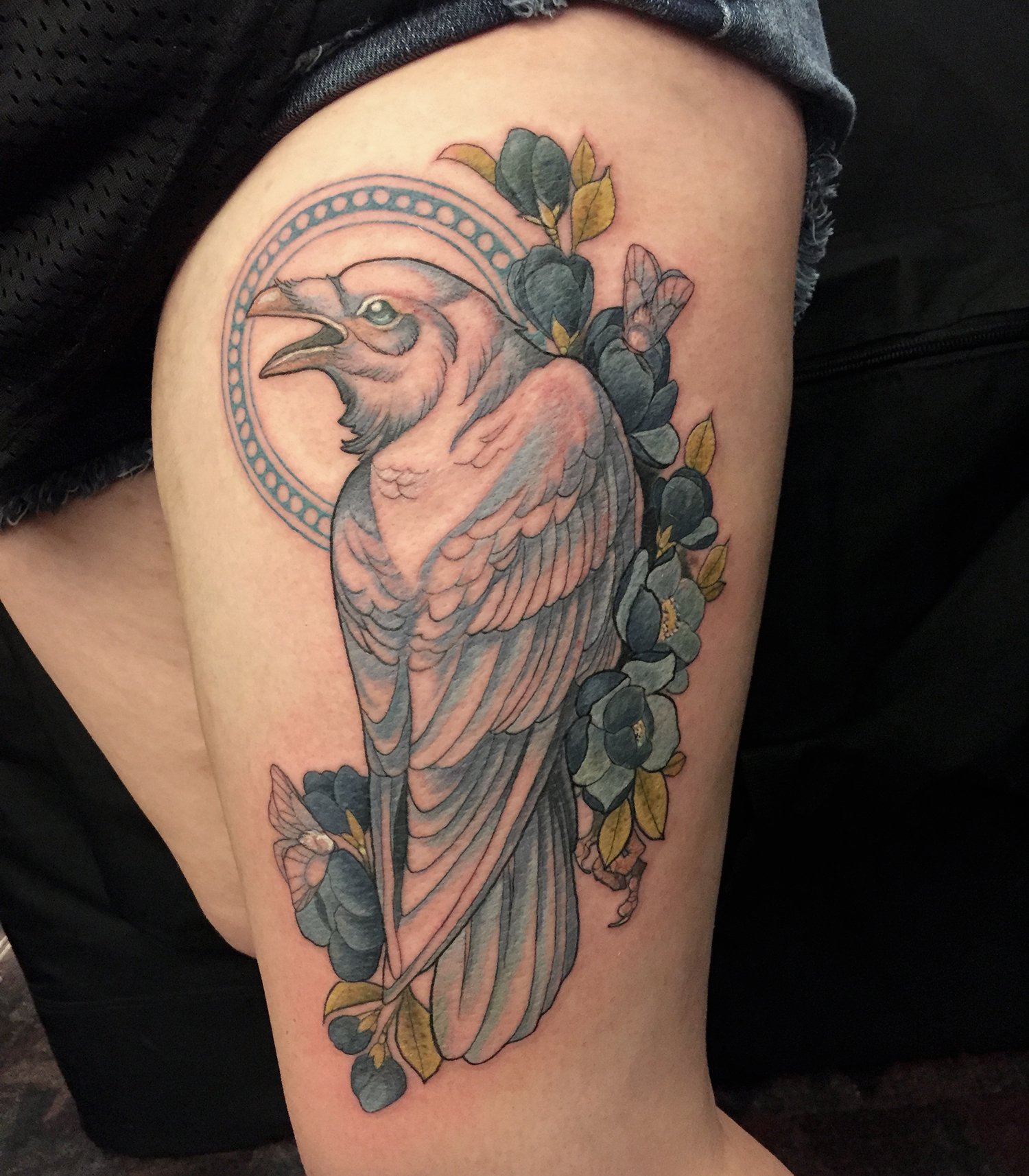
The white raven near completion on the final day of the Expo.
In some of your Instagram posts you specifically name the animals you draw, like the African Bee Eater. What do you use for reference material for these more realistic pieces?
Uh, well… If I have access to the animals, for example like I was literally walking downtown today and came across a rose garden and I was like “wait wait James I gotta stop and take photos of these.” If I have drawn it enough times I can kind of make it up or draw it on my own. You almost memorize the animal—like I’ve drawn foxes to the point where I can draw a fox in any position, but it does help if I can take photographs of things. Anytime I’m around animals I’ll try to photograph them as much as possible.
We even thought about doing a volunteer program in Africa and even potentially doing a write-off and taking photographs and things. But the internet really really helps. For example, the African Bee Eater—the girl, she’s like “I want birds on me. I don’t care what they are, they just have to be unique.” So I did a Kingfisher on her, and I knew the Kingfisher has a wide family so I wanted something in that general area, birds that were kind of semi-related to it. And so I had to look up the family of the Kingfisher and the Bee Eater came up and I’m like “oh that’s a gorgeous bird,” but the bird was never in the position that I wanted it to be.
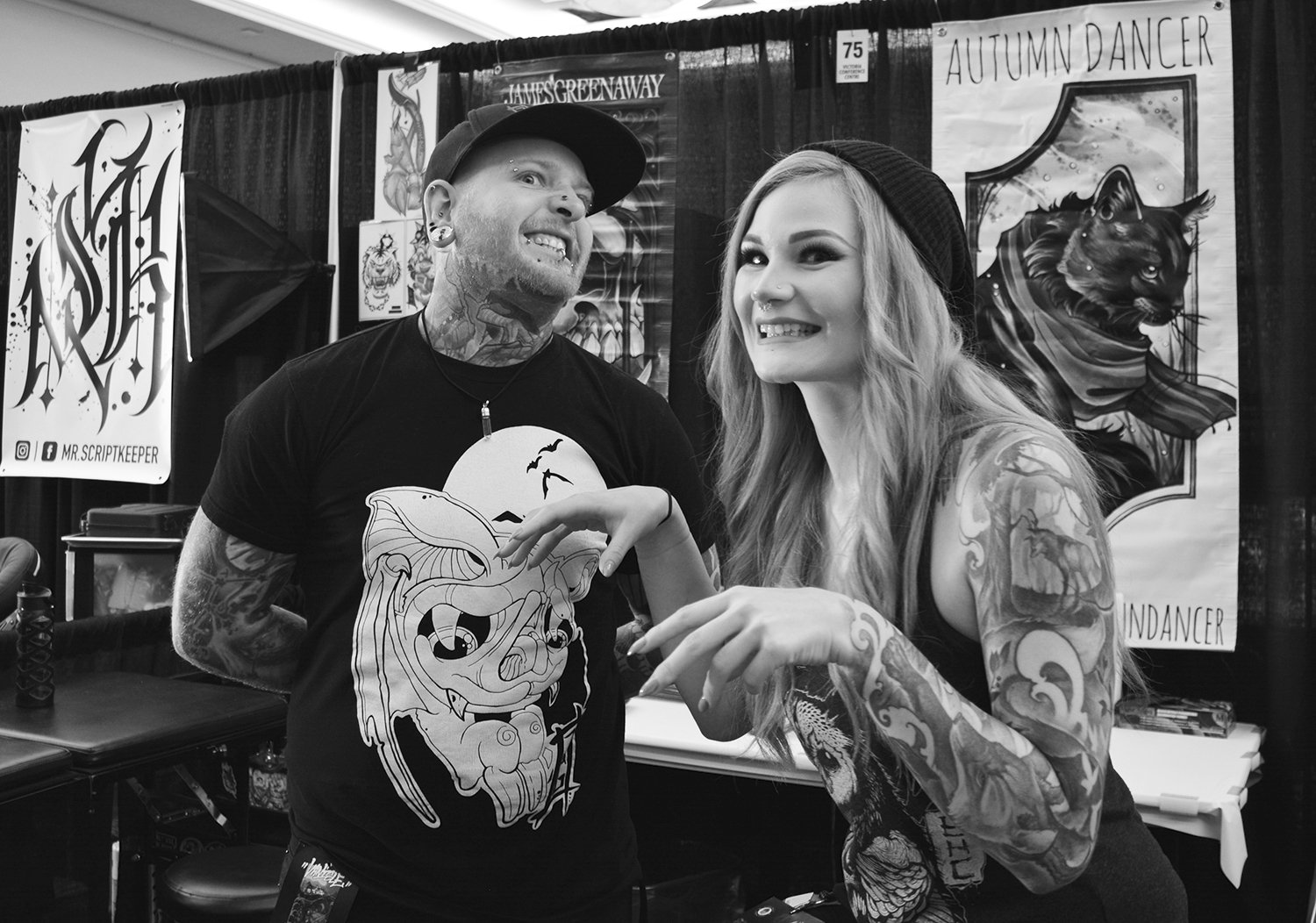
Autumn Dancer and partner James Greenaway having some fun at the expo.
Based on your online presence you seem very close with your peers at Capital Tattoos, particularly your partner James Greenaway (also present at the Expo). Could you please speak to what it is like having your work like and your personal life so closely linked.
Well I’m a subcontractor so I can make my own hours. This is the only career I can honestly think of where I can get up and leave, not have to tell my boss I am leaving, take my partner with me, and travel, and everybody is happy with it. I can make money travelling and y’know—my boss is the coolest. She is the only place where I have had the freedom to charge what I want, go on vacations when I want—we go to dinners together. Anytime someone has a bad day or if someone is pissed it stresses the entire shop out because—I see my shop more than I see my family, or my friends, or my cat.
It’s super important that you have a really strong bond with the people that you work with, because if you hate even one person it will irritate you to the point where do not want to work at that place, or your dread going to work. But I was good friends with James for years before I started working with him, and then about six months into working with him we started dating. Everyone thinks it’s—“how do you work somebody, and travel with somebody, and live with somebody?”
Fortunately for me he works at the other side of the shop so I see him five minutes a day. He peeks at what I’m doing, I’ll check out what he’s doing and that’s it, so it’s a really easy relationship. We’re so driven towards wanting to do conventions together, it really helps that we have the same mindset so we don’t have to worry about each other. We already know where we’re going and what we’re doing.
You see people six to eight to ten hours a day, you have to have a really close bond with them. We’re really lucky, especially being in a female-dominated shop it’s really difficult I find. People have that association that girls can be catty when working together, and as far I know the shop really mingles and jives really well and everyone has the same personality. So it’s really awesome.
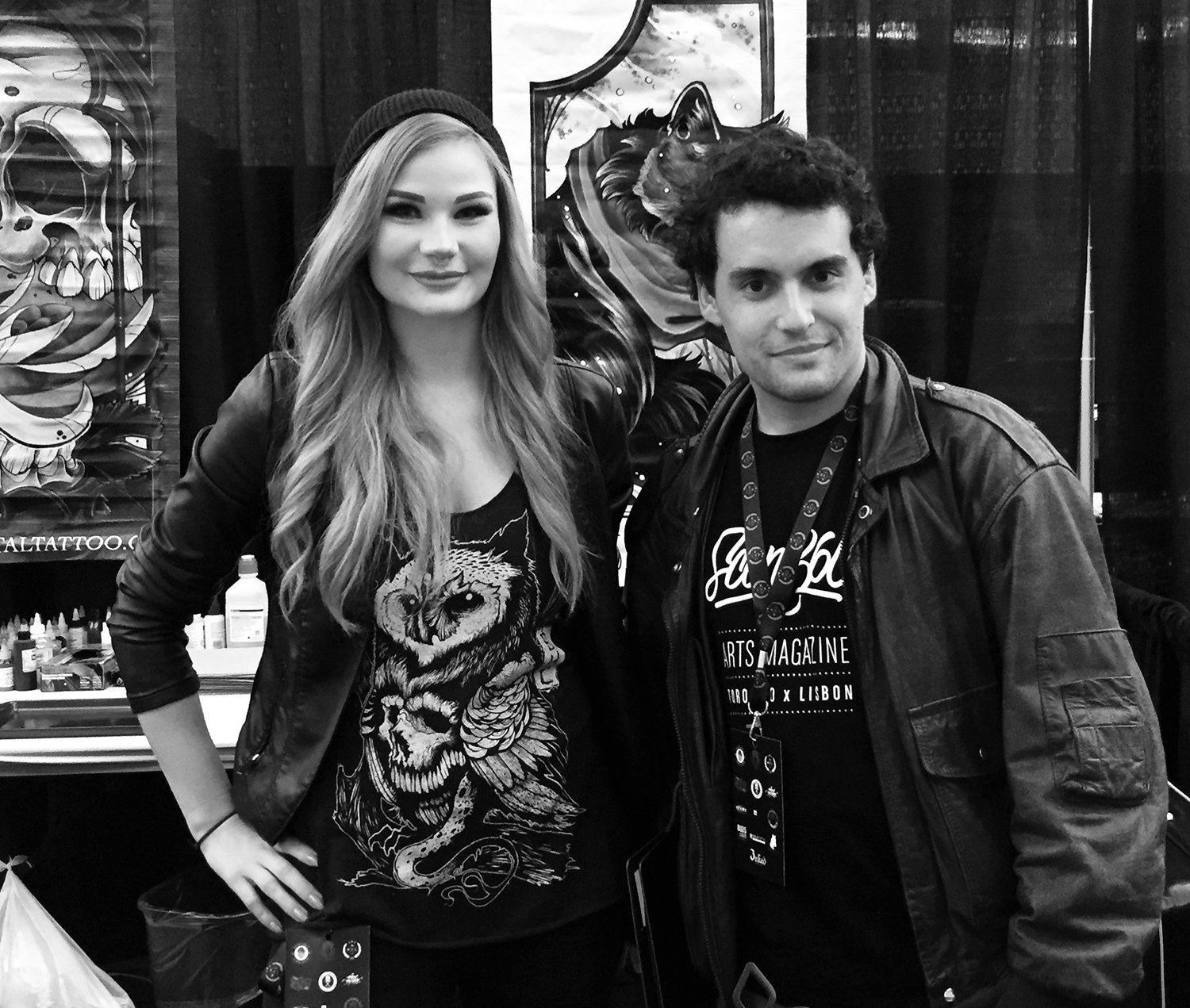
Autumn Dancer and Tony Carter (Scene360) at the Van Isle Tattoo Expo.
You mentioned that originally you did not want to get into tattooing because it seemed like a boy’s club. And you are working in a shop that is predominantly women. So what’s that like?
When I first started tattooing Bombshell wanted to do an all-female shop, and they ended up adding guys into the mix. But that was an issue, where everyone didn’t quite get along, so that shop didn’t quite work out as well. Kamikaze was mainly a male shop, and Capital, when I first started there, was only one girl and she had such a negative experience with other females that she’s like “I’m never hiring a girl again.” And then she ended up hiring me and she’s like “oh, girls aren’t so bad. I actually like working with girls.” And then she started hiring more and more women and it just worked out.
When I was seventeen/eighteen when I would look into shops when I was curious about getting tattooed I found that a lot of guys—it wasn’t necessarily the males that were the issue. I felt like as a younger teenager I was getting snobbed off a lot. They’re like “oh she just wants a script piece, whatever, she can get the apprentice” or something. This industry now is almost fifty/fifty. If you walk around the conventions there’s almost as many females as male tattoo artists, so I don’t think that’s an issue anymore. It’s definitely way less intimidating as a female. I feel like we have it way easier in this day and age than females had it ten, fifteen, twenty years ago where males were like “this is a boy’s job, why are you here?” Like I hear interviews with Megan Massacre and other women—like she did this interview where they said a guy peed in her water bottle at work because she was a girl. She got it so hard because she was a girl in the industry.
But I don’t think we have it any harder than males do at this point, I think we’re a lot more accepted. And, y’know females generally get more tattoos than guys. I find that males get larger pieces—they’ll get back pieces, full sleeves, leg pieces. Girls will get forty little tattoos. So I find that girls are getting more tattooed, so having a higher female presence in the industry too, we do a lot more feminine styles so it really appeals to a lot more of the girls who want to get tattooed, so it’s beneficial in that way as well.
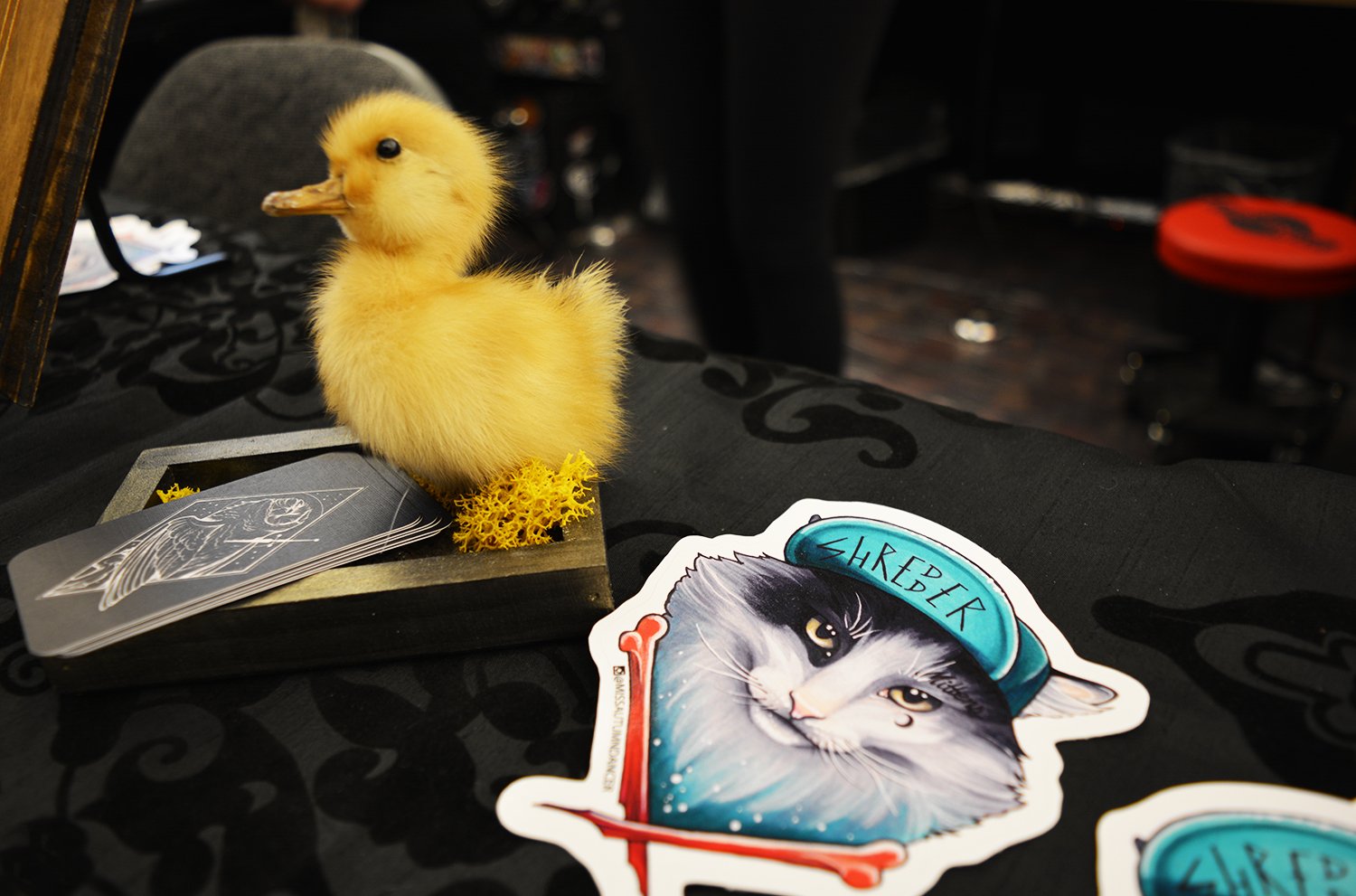
Dancer’s good luck duck greeted all comers at her table.
Based on some posts on social media we have seen that you do a lot of charity work; you do food and mittens for people in need, you volunteer with cops for cancer. Can you please speak to why that charity work is significant to you.
My favourite charity work I’ve done is Paws for a Cause and I’ve also done SCARS, so that’s animals that have been given a second chance. So when pet stores or rescues don’t think they can take on because of injury or maybe this cat is too violent—this charity will take them in and they will take care of them and then rehouse them. So they give these animals which were gonna be abandoned or put down a second chance at life. So I try to do that where I will do this free tattoo where I won’t make any money off of it and then I will do it super cheap so that entices someone to get the tattoo because it is cheaper, but at the same time all of the money gets volunteered to go to the cause so it is a win-win-win. I really feel like, unlike people where to an extent people can help themselves, animals don’t get the chance to do that. But I highly believe in karma.
So helping out any charities I can—like, another artist broke his hand so we ended up doing a free “anything we made that day,” our entire shop put our money towards, um, whatever we made we gave to him because he just had a baby, broke his hand, wouldn’t have been able to tattoo for three weeks or make an income. Our entire shop banded together and gave up all of the money we made that day, even the boss, even her cut, she gave it all to him to help him out. That would pay for at least part of his rent for that month.
I like helping where I can. I feel like I am an extremely fortunate person in an extremely fortunate career. I didn’t grow up with a lot, so being in a career where I can make my own hours and charge what I want, I feel like I can give whatever I can when I can to help someone else. One day that won’t affect me but it could affect them in their long term.
